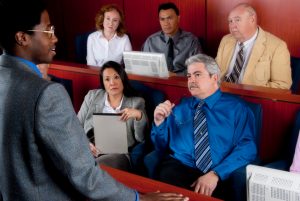Raise Your Legal Practice with Innovative Trial Presentations: Ideal Practices and Recommendations
Raise Your Legal Practice with Innovative Trial Presentations: Ideal Practices and Recommendations
Blog Article
Browsing the Complexities of Trial Presentations: Tips for Seamless Shipment and Compelling Arguments
In the realm of lawful procedures, the art of trial presentation stands as an essential component of success. The intricacies fundamental in trial discussions call for a fragile balance of strategy, finesse, and ability.

Understanding Trial Goals
To efficiently browse a test, it is important to have a clear understanding of the purposes that require to be attained. Prior to tipping right into the courtroom, lawful teams must define their objectives and desired results. These objectives act as guiding concepts throughout the test, shaping techniques and affecting decision-making processes.
Understanding test goals includes a detailed analysis of the situation, legal criteria, and the customer's benefits. Trial Presentations. It calls for a precise examination of the truths, identifying vital issues, and anticipating prospective challenges. By setting measurable and specific goals, lawyers can customize their disagreements and discussions to align with the desired outcomes
Furthermore, a clear grasp of trial objectives enables lawful groups to focus on proof, witnesses, and lawful debates effectively. It permits the advancement of a systematic story that resonates with the court and court, reinforcing the total case presentation.

Organizing Evidence Effectively
Having a clear understanding of test goals lays the structure for arranging proof successfully in lawful proceedings - Trial Presentations. By straightening the discussion of evidence with the wanted end results of the trial, legal teams can strengthen their disagreements and boost their persuasiveness. One critical facet of arranging proof is categorization. Organizing evidence based upon themes or relevance to specific legal aspects can assist streamline the presentation and make intricate details much more absorbable for the judge or jury.
One more key element in arranging evidence properly is establishing a sensible circulation. Offering proof in a sequential and meaningful way can help construct a compelling story that supports the lawful disagreements being made. Furthermore, using aesthetic help such as timelines, graphs, or graphes can additionally improve the company of proof and help in making clear intricate relationships or series of occasions.
Moreover, ensuring that all evidence presented is admissible and appropriate to the instance is necessary. Inadmissible or irrelevant proof can interfere with the toughness of the debate and potentially damage the reputation of the here and now celebration. Consequently, a thorough review and choice procedure must be taken on to consist of just the most impactful and lawfully sound proof in the trial discussion.
Crafting Convincing Narratives
Crafting compelling stories plays a crucial duty in presenting persuasive debates throughout legal process. When building a story for a trial presentation, it is important to develop a clear storyline that highlights key points and attaches them in a systematic manner. By weaving together evidence, testimony, and lawful disagreements right into a influential and cohesive narrative, lawful professionals can properly support for their clients and increase the probability of a positive end result in the courtroom.
Mastering Aesthetic Aids
Reliable use of aesthetic aids is vital to improving the influence and clearness of test discussions. Aesthetic aids, when utilized purposefully, have the power to streamline complicated info, strengthen key points, and leave an enduring perception on the discretionary. To understand visual aids in test presentations, it is critical to make certain that they are clear, concise, and pertinent to the arguments being made.
When integrating visual help, such as charts, pictures, timelines, or graphs, into a test presentation, it is important to maintain them aesthetically appealing yet expert. The visuals need to complement the verbal arguments, offering a graph of the info being discussed without overwhelming the target market with unneeded details.
Furthermore, exercising with the aesthetic aids in advance is imperative to guarantee a smooth delivery during the test. Familiarizing oneself with the content, transitions, and timings of each useful link aesthetic help pop over here can assist preserve the flow of the discussion and prevent technological problems that may emerge.
Delivering Impactful Closing Disagreements
An engaging closing disagreement serves as the conclusion of a trial discussion, encapsulating the core narrative and persuading the judge and jury in the direction of a beneficial decision. Begin by detailing the primary disagreements that sustain your customer's position, stressing why the evidence presented throughout the test sustains your story.
Furthermore, integrating emotional charm can further enhance your closing debate. Eventually, a well-crafted closing debate ought to leave a long-term impression, compelling the court and court to rule in your customer's support.
Conclusion
In conclusion, understanding test presentations includes comprehending objectives, organizing evidence, crafting stories, making use of aesthetic aids, and delivering impactful closing arguments. By implementing these techniques properly, legal representatives can present their situation effortlessly and make engaging arguments in the court room. It is vital to browse the intricacies of trial presentations with precision and ability to achieve success in legal process.
By straightening the presentation of proof with the wanted outcomes of the test, legal teams can reinforce their disagreements and enhance their persuasiveness (Trial Presentations). To understand aesthetic help in test presentations, it is critical to ensure that they are clear, succinct, and appropriate to the arguments being click to investigate made
A compelling closing disagreement offers as the end result of a test discussion, encapsulating the core story and persuading the court and court towards a beneficial choice. Begin by laying out the major arguments that sustain your client's setting, stressing why the proof provided throughout the test sustains your story.In verdict, mastering test discussions entails recognizing objectives, organizing evidence, crafting stories, making use of aesthetic aids, and supplying impactful closing arguments.
Report this page